Related Research Articles

The abacus, also called a counting frame, is a calculating tool which has been used since ancient times. It was used in the ancient Near East, Europe, China, and Russia, centuries before the adoption of the Hindu-Arabic numeral system. The exact origin of the abacus has not yet emerged. It consists of rows of movable beads, or similar objects, strung on a wire. They represent digits. One of the two numbers is set up, and the beads are manipulated to perform an operation such as addition, or even a square or cubic root.
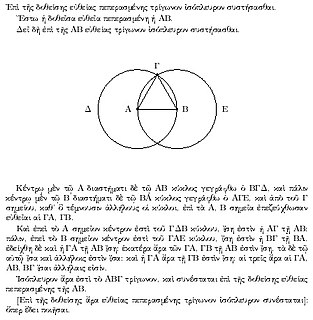
The history of mathematics deals with the origin of discoveries in mathematics and the mathematical methods and notation of the past. Before the modern age and the worldwide spread of knowledge, written examples of new mathematical developments have come to light only in a few locales. From 3000 BC the Mesopotamian states of Sumer, Akkad and Assyria, followed closely by Ancient Egypt and the Levantine state of Ebla began using arithmetic, algebra and geometry for purposes of taxation, commerce, trade and also in the patterns in nature, the field of astronomy and to record time and formulate calendars.

A number is a mathematical object used to count, measure, and label. The original examples are the natural numbers 1, 2, 3, 4, and so forth. Numbers can be represented in language with number words. More universally, individual numbers can be represented by symbols, called numerals; for example, "5" is a numeral that represents the number five. As only a relatively small number of symbols can be memorized, basic numerals are commonly organized in a numeral system, which is an organized way to represent any number. The most common numeral system is the Hindu–Arabic numeral system, which allows for the representation of any number using a combination of ten fundamental numeric symbols, called digits. In addition to their use in counting and measuring, numerals are often used for labels, for ordering, and for codes. In common usage, a numeral is not clearly distinguished from the number that it represents.

Papyrus is a material similar to thick paper that was used in ancient times as a writing surface. It was made from the pith of the papyrus plant, Cyperus papyrus, a wetland sedge. Papyrus can also refer to a document written on sheets of such material, joined side by side and rolled up into a scroll, an early form of a book.
0 (zero) is a number, and the numerical digit used to represent that number in numerals. It fulfills a central role in mathematics as the additive identity of the integers, real numbers, and many other algebraic structures. As a digit, 0 is used as a placeholder in place value systems. Names for the number 0 in English include zero, nought (UK), naught, nil, or—in contexts where at least one adjacent digit distinguishes it from the letter "O"—oh or o. Informal or slang terms for zero include zilch and zip. Ought and aught, as well as cipher, have also been used historically.
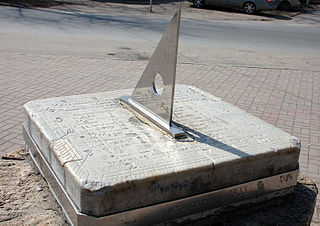
A gnomon is the part of a sundial that casts a shadow. The term is used for a variety of purposes in mathematics and other fields.
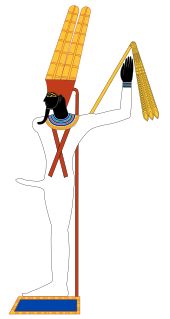
Min is an ancient Egyptian god whose cult originated in the predynastic period. He was represented in many different forms, but was most often represented in male human form, shown with an erect penis which he holds in his right hand and an upheld left arm holding a flail.
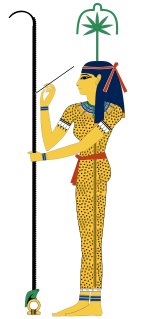
Seshat, Ancient Egyptian: sš3t, under various spellings, was the ancient Egyptian goddess of writing, wisdom, and knowledge. She was seen as a scribe and record keeper; her name means "female scribe". She is credited with inventing writing. She also became identified as the goddess of accounting, architecture, astronomy, astrology, building, mathematics, and surveying.
A numerical digit is a single symbol used alone or in combinations, to represent numbers in a positional numeral system. The name "digit" comes from the fact that the ten digits of the hands correspond to the ten symbols of the common base 10 numeral system, i.e. the decimal digits.

An Egyptian fraction is a finite sum of distinct unit fractions, such as
The system of ancient Egyptian numerals was used in Ancient Egypt from around 3000 BCE until the early first millennium CE. It was a system of numeration based on multiples of ten, often rounded off to the higher power, written in hieroglyphs. The Egyptians had no concept of a place-valued system such as the decimal system. The hieratic form of numerals stressed an exact finite series notation, ciphered one-to-one onto the Egyptian alphabet.
Ancient Egyptian mathematics is the mathematics that was developed and used in Ancient Egypt c. 3000 to c. 300 BCE, from the Old Kingdom of Egypt until roughly the beginning of Hellenistic Egypt. The ancient Egyptians utilized a numeral system for counting and solving written mathematical problems, often involving multiplication and fractions. Evidence for Egyptian mathematics is limited to a scarce amount of surviving sources written on papyrus. From these texts it is known that ancient Egyptians understood concepts of geometry, such as determining the surface area and volume of three-dimensional shapes useful for architectural engineering, and algebra, such as the false position method and quadratic equations.

The Attic numerals are a symbolic number notation used by the ancient Greeks. They were also known as Herodianic numerals because they were first described in a 2nd-century manuscript by Herodian; or as acrophonic numerals because the basic symbols derive from the first letters of the (ancient) Greek words that the symbols represented.

Greek mathematics refers to mathematics texts and ideas stemming from the Archaic through the Hellenistic and Roman periods, mostly extant from the 7th century BC to the 4th century AD, around the shores of the Eastern Mediterranean. Greek mathematicians lived in cities spread over the entire Eastern Mediterranean from Italy to North Africa but were united by Greek culture and the Greek language. The word "mathematics" itself derives from the Ancient Greek: μάθημα, romanized: máthēmaAttic Greek: [má.tʰɛː.ma]Koine Greek: [ˈma.θi.ma], meaning "subject of instruction". The study of mathematics for its own sake and the use of generalized mathematical theories and proofs is an important difference between Greek mathematics and those of preceding civilizations.

Deshret was the formal name for the Red Crown of Lower Egypt and for the desert Red Land on either side of Kemet, the fertile Nile river basin. When combined with the Hedjet of Upper Egypt, it forms the Pschent, in ancient Egyptian called the sekhemti.

The pous or Greek foot (pl. feet) was a Greek unit of length. It had various subdivisions whose lengths varied by place and over time. 100 podes made up one plethron, 600 podes made up a stade and 5000 made up a milion. The Greek pous also has long, median and short forms.
In mathematics, ancient Egyptian multiplication, one of two multiplication methods used by scribes, is a systematic method for multiplying two numbers that does not require the multiplication table, only the ability to multiply and divide by 2, and to add. It decomposes one of the multiplicands into a set of numbers of powers of two and then creates a table of doublings of the second multiplicand by every value of the set which is summed up to give result of multiplication.
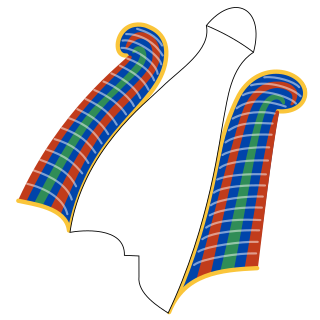
Atef is the specific feathered white crown of the ancient Egyptian deity Osiris. It combines the Hedjet, the white crown of Upper Egypt, with curly red ostrich feathers on each side of the crown for the Osiris cult. The feathers are identified as ostrich from their curl or curve at the upper ends, with a slight flare toward the base. They are the same feather as (singly) worn by Maat. They may be compared with the falcon tail feathers in two-feather crowns such as those of Amun, which are more narrow and straight without curve.

The Rhind Mathematical Papyrus is one of the best known examples of ancient Egyptian mathematics. It is named after Alexander Henry Rhind, a Scottish antiquarian, who purchased the papyrus in 1858 in Luxor, Egypt; it was apparently found during illegal excavations in or near the Ramesseum. It dates to around 1550 BC. The British Museum, where the majority of the papyrus is now kept, acquired it in 1865 along with the Egyptian Mathematical Leather Roll, also owned by Henry Rhind. There are a few small fragments held by the Brooklyn Museum in New York City and an 18 cm (7.1 in) central section is missing. It is one of the two well-known Mathematical Papyri along with the Moscow Mathematical Papyrus. The Rhind Papyrus is larger than the Moscow Mathematical Papyrus, while the latter is older.
The Lahun Mathematical Papyri is an ancient Egyptian mathematical text. It forms part of the Kahun Papyri, which was discovered at El-Lahun by Flinders Petrie during excavations of a workers' town near the pyramid of the 12th dynasty pharaoh Sesostris II. The Kahun Papyri are a collection of texts including administrative texts, medical texts, veterinarian texts and six fragments devoted to mathematics.
References
- Gillings, Richard J. (1982). Mathematics in the Time of the Pharaohs . Dover Publications. ISBN 9780486243153. OCLC 301431218.
- Clagett, Marshall (1989). Ancient Egyptian Science: Ancient Egyptian mathematics. American Philosophical Society. ISBN 9780871692320. OCLC 313400062.
- Bunt, Lucas N. H.; Jones, Phillip S.; Bedient, Jack D. (2012). The Historical Roots of Elementary Mathematics. Dover Publications. ISBN 9780486139685. OCLC 868272907.
